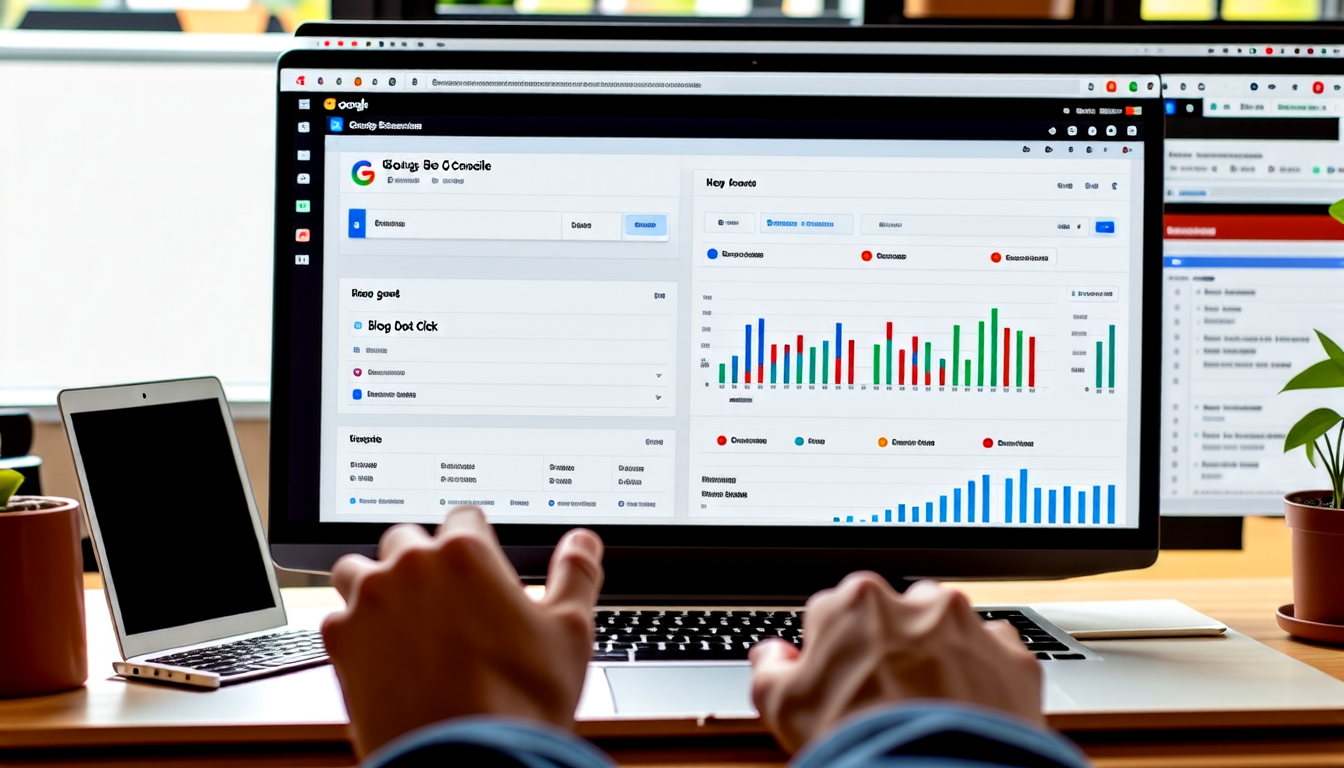How To Optimize Your Blog for SEO: A Step-by-Step Guide
Ever wondered how to optimize your blog for SEO? It might seem tricky, but it’s like planting a garden. You need the right tools and a bit of patience. In this guide, we’ll walk you through each step. From crafting the perfect blog post title to using effective SEO plugins.
You’ll learn how to make your content shine on Google. We’ll cover everything from on-page SEO to fixing pesky technical SEO issues.
By the end, you’ll see why blog SEO is important and how it can boost your search traffic. So, grab a coffee, and let’s dive into making your blog posts the best they can be!
Key Takeaways
-
Identify and use the right keywords to align with search intent and boost visibility.
-
Craft high-quality blog posts that engage readers and satisfy search engines.
-
Implement on-page SEO techniques like meta tags and internal linking.
-
Monitor your SEO progress using Google Search Console to make data-driven adjustments.
-
Regularly refresh and update old blog posts to maintain relevance and improve rankings.

Why Does Your Blog Need SEO?
To optimize your blog for SEO, start by focusing on your content. Use keywords naturally within your blog posts. Creating engaging and useful content helps attract readers and boosts SEO. Pay attention to your blog post title; it should be catchy yet informative.
Technical SEO issues can affect your ranking, so ensure your site runs smoothly. Use SEO plugins if you’re on WordPress. Remember to craft posts for SEO by incorporating relevant keywords and making them search-friendly.
Lastly, monitor your search traffic and tweak your strategy as needed. Google loves fresh, updated content, so keep posting regularly.
The Crucial Role of Content in SEO Optimization
Optimizing your blog for SEO is like fine-tuning a musical instrument. Start by choosing a focus keyword for each post. Make sure your keywords appear naturally in your titles and content. Use SEO plugins to help with on-page SEO. These tools can identify technical SEO issues that may be affecting your search traffic. Don’t forget the power of visuals—images can make your posts more engaging. Google loves well-structured blogs with relevant content. Regularly update your wordpress blog posts to keep them fresh. This not only helps with SEO but also keeps your readers engaged.

10 Steps to Skyrocket Your Blog SEO
Achieving top-notch SEO for your blog requires a strategic approach. Start by identifying your focus keyword for each post. Use tools like Google Keyword Planner to find relevant terms with high search volume. Integrate these keywords naturally into your blog content, including titles and headings. SEO plugins for platforms like WordPress can assist in optimizing your posts for SEO.
Ensure your content is valuable and engaging to keep readers hooked. Regularly update old posts to maintain relevance and improve search traffic. Quality blog posts makes a significant impact on your blog SEO important for long-term success.

Step 1: Identifying and Using the Right Keywords
Finding the right focus keyword can make or break your blog’s success. Imagine you’re a fisherman; you need the right bait to catch fish. Well, keywords are your bait in the digital sea. Start by using tools like Google Keyword Planner to search for popular terms. Incorporate these words naturally into your posts. This helps search engines like Google understand your content. Also, sprinkle related terms throughout your text. Don’t stuff keywords, though! Quality matters. Think about what your readers want and how they search. Keep your blog SEO on point by reviewing and updating your keywords regularly. Optimize your blog effectively.

Step 2: Understanding and Aligning with Search Intent
Understanding what your audience is searching for is key. Think about how they phrase their queries. Are they looking for tips or guides? Tailor your content to match these needs. This not only helps you rank better on Google but also keeps your readers engaged.
Imagine you’re a detective, always trying to figure out the clues left by users. Use these insights to create blog posts that answer their questions directly. Optimize your blog by adding relevant keywords naturally. Make sure your posts are easy to read and provide real value.
Remember, SEO is like planting a garden. It takes time to see the results, but with patience, your efforts will bloom.

Step 3: Crafting Quality Blog Posts
Creating engaging blog posts is key to boosting your blog SEO. Think about what will resonate with your readers and what keywords they might use in a search. Use those keywords naturally in your content to improve your position on Google. To keep your audience interested, mix up your posts with various styles and lengths. This keeps things fresh and encourages more search traffic. Additionally, focus on on-page SEO elements like headings and images. Regularly updating your blog with new posts can also help maintain interest and improve visibility. Follow these SEO blog tips to optimize your blog effectively.
Step 4: Implementing On-Page SEO Techniques
When you’re working on your blog, you’ll want to make sure each post shines. Start by selecting a focus keyword that’s relevant to your topic. This helps both readers and search engines like Google understand what your content is about. Don’t forget to use this keyword naturally throughout your post. Also, craft engaging titles and meta descriptions to grab attention. Use headings, bullet points, and images to make your blog posts easy to read. Last but not least, always add internal and external links to provide value and context. This strategy will boost your SEO and make your blog more appealing.

Step 5: Making Your Blog Posts Reader-Friendly
To make your blog appealing, keep your paragraphs short and sweet. Start with an engaging intro. Address your readers directly. This keeps them hooked. Use bullet points and subheadings to break up the text. It makes it easier to scan.
Images, videos, and infographics can make your content pop. Ensure your website is mobile-friendly. Many readers use their phones. Don’t forget about SEO. Use your focus keyword naturally.
Make sure to proofread. Spelling mistakes can be a turn-off. Lastly, engage with your readers. Reply to comments and encourage discussions. This builds a sense of community around your blog.

Step 6: Addressing Technical SEO Issues
Technical improvements are critical for enhancing your blog’s visibility. Ensure your site is mobile-friendly. More and more users are accessing content on mobile devices, and Google prioritizes mobile-friendly sites in search results. Next, improve your site speed. Faster load times lead to better user experiences and higher rankings.
Fix broken links immediately. They can frustrate visitors and harm your blog’s credibility. Check your site’s structure. A clear, logical structure helps search engines crawl your site more effectively.
Remember to use structured data. It helps search engines understand your content better. Proper use of meta tags and alt text can also boost visibility.
Step 7: Harnessing the Power of Backlinks
Backlinks are the backbone of SEO. They act as votes of confidence from other websites. If you get links from high-authority sites, your blog climbs up in search rankings. But not just any link will do. Aim for quality over quantity. Reach out to bloggers, offer guest posts, or create shareable content. These tactics can boost your site’s credibility. Additionally, always keep an eye on your backlinks to avoid harmful links. Tools like Google Search Console can help. Keep your focus keyword in mind, but don’t overdo it. Balance is key. Happy blogging!
Step 8: Refreshing and Updating Old Blog Posts
Keeping your blog fresh is key to maintaining SEO. Readers and Google alike love new, relevant content. Review your posts for outdated information. Replace broken links. Add new insights or data. This ensures your blog stays valuable. Update your focus keyword to reflect trending search terms. Enhance readability by breaking up long paragraphs. Use bullet points where appropriate. Don’t forget images; they make your blog posts engaging. Refreshing old blogs isn’t just about SEO. It’s about offering value to your readers. Your effort will pay off in higher search rankings and more engaged visitors.
Step 9: Organizing Your Content with Categories and Tags
Categories and tags help organize your blog. Think of them as a roadmap guiding your readers. Categories are broad topics, while tags zero in on specifics. For instance, if you write about cooking, a category could be “Desserts,” with tags like chocolate or “cheesecake.” This boosts your content‘s visibility on Google. Use unique categories for each post and avoid overlap. Properly done, this makes your posts easier to find and read. Don’t over-tag; stick to 5-10 relevant tags. This keeps things tidy and enhances your blog’s structure. So, focus on smart organization to make your blog seo important!
Step 10: Monitoring Your SEO Progress with Google Search Console
You’ve put in the hard work to get your blog up and running. Now, it’s time to see how your efforts are paying off. To track your progress, use tools like Google Search Console. It’s a game-changer for understanding how your content performs.
You’ll get insights into which keywords are driving traffic to your posts. Don’t forget to check which blog posts are getting the most clicks. This data helps you fine-tune your strategy. If you’re using WordPress, keep an eye on your wordpress blog posts and make adjustments as needed. This way, your blog will continually improve and attract more readers.

How to Continually Optimize Your Blog for SEO: Tips and Strategies
To get started, pick a focus keyword and sprinkle it naturally throughout your posts. Think of this keyword as the thread running through your content. Next, write engaging posts that answer questions people might search for. Imagine you’re chatting with a friend who needs advice.
Use headings to break up text and include your target keyword. Don’t forget to add images with descriptive alt text. Another trick? Link to other relevant posts on your site and external sources. This helps Google understand your site’s content. Lastly, keep updating your posts to reflect current information, ensuring they stay relevant.

Conclusion
Optimizing your blog for SEO is a marathon, not a sprint. It requires ongoing effort and attention. However, with consistent application of the steps outlined, you can significantly improve your blog’s visibility and traffic. Remember, the key is to create quality content that addresses your audience’s needs.
Keep an eye on your SEO progress using tools like Google Search Console. This will help you understand what’s working and what needs adjustment. Stay updated with SEO trends and continue to refine your strategy. By doing so, you’ll not only improve your blog’s ranking but also build a loyal readership.
FAQ
1. How do I find the right keywords for my blog?
Start by using tools like Google Keyword Planner, Moz, or SEMrush. These tools can help you discover what people are searching for. Focus on long-tail keywords (phrases with three or more words) because they typically have less competition and are easier to rank for. Also, think about what questions your readers might have and use those as keywords.
2. What is search intent and why is it important?
Search intent is the reason behind a search query. It’s about understanding what the user is really looking for. For instance, if someone searches for “best running shoes,” they might be ready to buy running shoes. Aligning your content with the search intent helps you meet the needs of your audience, which can improve your ranking on search engines.
3. How can I make my blog posts more reader-friendly?
Write in short paragraphs and use bullet points or numbered lists to break up the text. Use engaging headings and subheadings. Incorporate images or videos to add visual interest. Make sure your content is easy to read by using a conversational tone and simple language.
4. What are backlinks and why are they important?
Backlinks are links from other websites to your blog. They are crucial because they signal to search engines that your content is authoritative and valuable. Getting backlinks from reputable sites can boost your blog’s credibility and improve your search engine ranking.
5. How often should I update my old blog posts?
Regularly updating old posts keeps your content fresh and relevant. Aim to review and update your posts at least once a year. Check for outdated information, add new insights, and improve the SEO elements like keywords and meta descriptions. This can help maintain and even improve your ranking over time.

